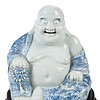Three Chinese Tian-Tsui Hair Ornaments on Lucite Stands
Bid Increments
| Price | Bid Increment |
|---|---|
| $0 | $25 |
| $100 | $50 |
| $1,000 | $100 |
| $2,000 | $200 |
| $3,000 | $250 |
| $5,000 | $500 |
| $10,000 | $1,000 |
| $20,000 | $2,000 |
| $50,000 | $5,000 |
| $100,000 | $10,000 |
Qing dynasty, silver or gilt metal frames with blue kingfisher feather inlay and bead ornaments, 3 in. to 3-3/4 in.; mounted on custom Lucite stands, 2-1/2 x 4 in.
Note: Kingfisher feather ornaments adorned the ladies of the Chinese court since the Tang Dynasty. These brilliant blue feathers came from water kingfishers and wood kingfishers, which were common in China. From large, ornamented, lacquer panel screens, to lavish headdresses and hats, down to small, fine, elegant jewelry such as earrings and hair pins, the Chinese have elevated this beautiful, delicate feather to great technical and visually creative heights. The striking iridescent blue of kingfisher feathers has been highly prized in China for at least 2500 years. Their widespread use in hair ornaments and jewelry gave rise to their being acknowledged as symbols of feminine beauty, while the sheer reality that a kingfisher is an extremely small bird and difficult to either catch or rear in captivity caused them to become symbols of wealth and social standing. While once only available to the Imperial Court, over the centuries this filtered down into the aristocratic strata of society and became another source for silversmiths to create an art form that was excruciatingly difficult and time consuming to produce. The art of kingfisher feather inlay, known in China as the art of tian tsui, literally means ?dotting with kingfisher?. (Vastari)
Provenance: Private Collection, ColoradoCondition
some losses to feather inlay, metal with some discoloration/tarnish; example with mirror panel with surface dirt and scratches to mirror, wire border loose, top row of beads not secure
Purchased items will be available for pick up or shipping from our Asheville, North Carolina auction facility within ten business days of the auction will be assessed a storage fee of $5.00 per day, per item. Purchaser agrees that packing and shipping is done at the purchaser's risk and that the purchaser will pay in advance all packing expenses, materials, carrier fees and insurance charges. At our discretion, items will either be packed by an agent such as a packaging store or Brunk Auctions. Please allow two weeks for shipping after payment is received. Shipment of large items is the responsibility of the purchaser. We are happy to provide names of carriers and shippers if a purchaser so requests. Brunk Auctions will have no liability for any loss or damage to shipped items.










